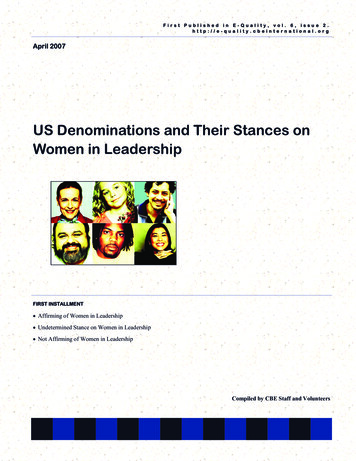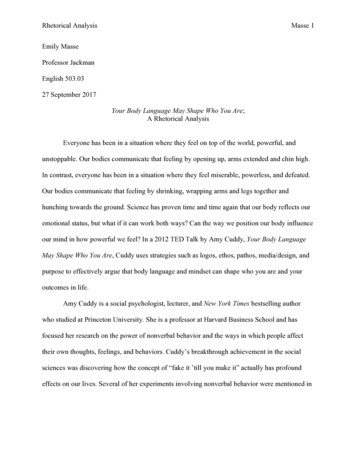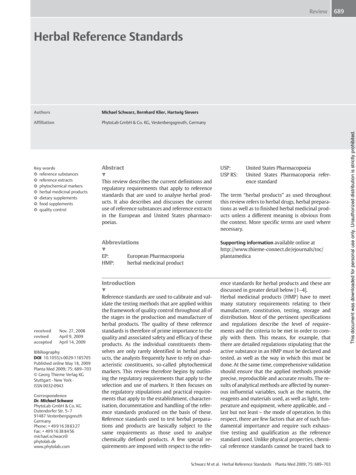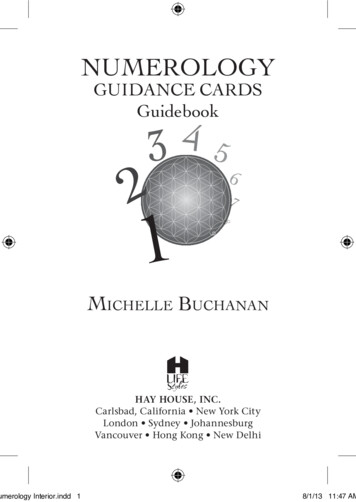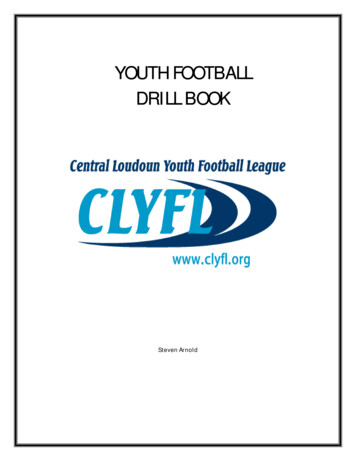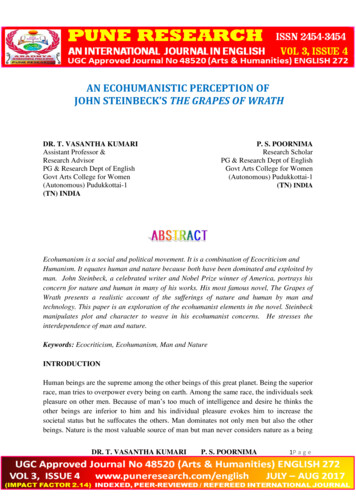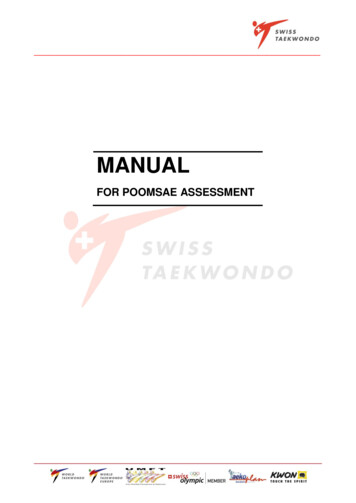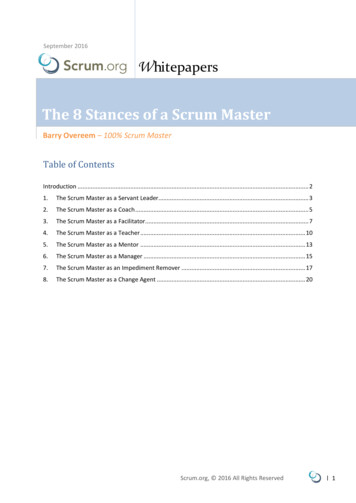
Transcription
September 2016W hitepapersThe 8 Stances of a Scrum MasterBarry Overeem – 100% Scrum MasterTable of ContentsIntroduction . 21.The Scrum Master as a Servant Leader. 32.The Scrum Master as a Coach . 53.The Scrum Master as a Facilitator. 74.The Scrum Master as a Teacher . 105.The Scrum Master as a Mentor . 136.The Scrum Master as a Manager . 157.The Scrum Master as an Impediment Remover . 178.The Scrum Master as a Change Agent . 20Scrum.org, 2016 All Rights Reserved 1
IntroductionAccording to the Scrum Guide, the Scrum Master is responsible for ensuring Scrum is understood andenacted. Scrum Masters do this by ensuring that the Scrum Team adheres to Scrum theory, practices, andrules.The Scrum Master is a servant-leader for the Scrum Team. The Scrum Master helps those outside theScrum Team understand which of their interactions with the Scrum Team are helpful and which aren’t.The Scrum Master helps everyone change these interactions to maximize the value created by the ScrumTeam.The role of a Scrum Master is one of many stances and diversity. A great Scrum Master is aware of themand knows when and how to apply them, depending on situation and context. Everything with the purposeof helping people understand the spirit of Scrum.The Scrum Master Acts as a: Servant Leader whose focus is on the needs of the team members and those they serve (thecustomer), with the goal of achieving results in line with the organization’s values, principles, andbusiness objectives. Coach coaching the individual with a focus on mindset and behavior, the team in continuousimprovement and the organization in truly collaborating with the Scrum Team. Facilitator by setting the stage and providing clear boundaries in which the team can collaborate. Teacher to ensure Scrum and other relevant methods are understood and enacted. Mentor that transfers agile knowledge and experience to the team. Manager responsible for managing impediments, eliminating waste, managing the process,managing the team’s health, managing the boundaries of self-organization, and managing theculture. Impediment Remover solving blocking issues to the team’s progress, taking into account theself-organizing capabilities of the Development Team. Change Agent to enable a culture in which Scrum Teams can flourish.This white paper contains my personal experiences acting as a Scrum Master. Besides these experiences,I’ve added my most important findings while researching the 8 different stances studying books, articlesand videos. I hope you enjoy the result! 2Scrum.org, 2016 All Rights Reserved
1. The Scrum Master as a Servant LeaderServant-leadership is fully in line with the Scrum values of courage, openness, respect, focus andcommitment. It’s the backbone of the Scrum Master role and therefore the most obvious one todescribe first. In this part, I’ll describe what servant-leadership is about, the connection with the AgileManifesto, and how the Scrum Master acts as a servant-leader.What is Servant-Leadership?It’s a philosophy and a set of practices that enrich the lives of individuals, to build better organizations,and ultimately create a more just and caring world. It’s a transformational approach to life and workthat has the potential for creating positive change throughout our society. Servant-leadership focuseson collaboration, trust, empathy and the usage of power ethically.Servant-leadership is about: Serving others, not yourselfNot leading by titleLeadership that enduresHelping people develop and perform as highly as possibleSelfless management of team membersPromoting genuine team ownershipHarnessing the collective power of a teamWhat is a Servant-Leader?Robert K. Greenleaf, the originator of the term ‘servant-leadership’, describes a servant-leader as,“The servant-leader is a servant first. It begins with the natural feeling that one wants to serve. Thenconscious choice brings one to aspire to lead. The best test is: do those served grow as persons: dothey, while being served, become healthier, wiser, freer, more autonomous, more likely themselvesto become servants? And, what is the effect on the least privileged in society; will they benefit, or, atleast, not be further deprived?1”The servant-leaders’ objective is to enhance and increase teamwork and personal involvement. Theycreate a participative environment, empowering ‘employees’ by sharing power and decision-making2.A servant-leader: 12Focuses on building a foundation of trustStimulates empowerment and transparencyEncourages collaborative engagementsIs an un-blocker and empathetic person able to truly listenShows ethical and caring behaviour, putting others’ needs firstIs humble, knowledgeable, positive, social and situationally awareGreenleaf, Robert K. Servant Leadership: A Journey into the Nature of Legitimate Power and e-servant-leaderScrum.org, 2016 All Rights Reserved 3
The Agile Manifesto and Servant-LeadershipThe characteristics of servant-leadership can also be found within the Agile Manifesto3. The values‘individuals and interactions over processes and tools’ and ‘customer collaboration over contractnegotiation’ clearly emphasize the focus on collaborative engagements, serving others (the teammembers) and not yourself and boosting team performance by supporting individual growth.Principles of the Agile Manifesto that also characterize servant-leadership are: “Build projects around motivated individuals. Give them the environment and support theyneed, and trust them to get the job done.” “Business people & developers must work together daily throughout the project.”The Scrum Master as a Servant-LeaderThe Scrum Guide describes the Scrum Master as the servant-leader for the Scrum Team. A ScrumMaster is not master of the team, but a master at encouraging, enabling, and energizing people to gelas a team and realize their full potential4. A Scrum Master is a servant-leader whose focus is on theneeds of the team members and those they serve (the customer), with the goal of achieving results inline with the organization’s values, principles, and business objectives5.The Scrum Master leads by example, by respect, and by the ability to influence the organization forthe Scrum Team and its effectiveness. The Scrum Master should also lead by values, by courage andcommitment, but also by stubbornness. Stubborn by having strong beliefs and the intention to changethe organization.As a servant-leader, the Scrum Master is responsible for: Setting up Scrum as a servant process, not a commanding process6Guiding the Development Team towards self-organizationLeading the team through healthy conflict and debateTeaching, coaching and mentoring the organization and team in adopting and using ScrumShielding the team from disturbance and external threatsHelping the team make visible, remove and prevent impedimentsEncouraging, supporting and enabling the team to reach their full potential and abilitiesCreating transparency by radiating information via e.g. the Product Backlog and SprintBacklog, Daily Scrum, reviews and a visible workspaceEnsuring a collaborative culture exists within the teamClosingServant-leadership proves to be the backbone of the Scrum Master role. Its philosophy and practicesincrease teamwork and create an environment in which individual growth can flourish and endure. Asa servant-leader, the Scrum Master can help the team act upon the Scrum values of courage,openness, respect, focus and commitment and realize their full potential.3http://www.agilemanifesto.org/Watts, Geoff. Scrum Mastery: From Good to Great Servant p-challenge6Verheyen, Gunther. Scrum: A Pocket Guide4Scrum.org, 2016 All Rights Reserved 4
2. The Scrum Master as a CoachThis chapter is about the Scrum Master as a coach. The Scrum Master is often considered a coach forthe team, helping the team do the best work they can to reach the Sprint Goal. In this chapter, I’lldescribe what coaching is about and share the three perspectives a Scrum Master can use when actingas a coach.What is Coaching?There are a lot of good definitions available that describe coaching. My ultimate definition is:“Coaching is unblocking a person’s potential to maximize their own performance. It is helping peopleto learn rather than teach them7.”Other good definitions are: “The ultimate goal of coaching is to help the client understand themselves better so that theycan find to make the most of their potential8.” “Effective coaching is guiding without prescribing9.” “The art of facilitating the performance, learning and development of another10.” “Coaching closes the gap between thinking about doing and actually doing11.”What is Effective Coaching?Via Portia Tung’s website, Selfish Programming, I came across “The 7 Habits of Highly EffectiveCoaches12.” A Scrum Master can use these habits to check if she/he is doing coaching in a way thechances of success will be the highest. The habits she describes are: Lead by example. This means living by the values and principles they espouse as well asapplying the tools and techniques they know to themselves and to their work. Begin with the end in mind. A coach works backwards from the goal to figure out the mosteffective and efficient way of getting from A to B. Set a sustainable pace. A coach stays calm when others around them lose their heads. Think with your head and feel with your heart. A coach balances thinking and feeling.They apply logical thinking as well as empathy when solving problems. Pull, not push. A coach waits and is always ready when someone asks for help. A coachcreates and offers learning opportunities instead of thrusting their ideas, advice and viewsonto others.7Sir John WhitmoreWatts, Geoff, and Kim Morgan. The Coach's Casebook: Mastering the Twelve Traits That Trap tive-agile-coaching/10Downey, Myles. Effective Coaching11Martin, Curly. The Life Coaching crum.org, 2016 All Rights Reserved 5
Talk less, listen more. A coach postpones judgement on what they hear and lets others talkwhile they listen with care. Flow like a stream. A coach is patient, pragmatic and present.The Scrum Master as a CoachTo describe the Scrum Master as a coach, three different perspectives can be used: the individual, theteam and the organization. Coaching the individual with a focus on mindset and behaviour, the teamin continuous improvement and the organization in truly collaborating with the Scrum Teams.Coaching the Individual Explain the desired mindset and behaviour, help individuals see new perspectives andpossibilities Influence the individual team members to use Scrum well Help each person take the next step on his or her agile journey13Coaching the Team Stimulate a mindset of continuous improvement, create a learning culture Support the team in problem solving and conflict resolution Coach the team to develop “to the point that members learn how to best learn from oneanother” Change the attitude, mindset and behaviour that restrict the team from doing Scrum well Coach the team in giving each other open and honest feedbackCoaching the Organization Help the organization achieve astonishing results by delivering high quality, valuable products Coach the entire organization in doing product management with a focus on continuouslyadding business value Support and encourage collaboration and cooperation with the Scrum TeamsClosingBy doing some research, I’ve created a brief description of the Scrum Master as a coach. Besidessharing the most common definitions of ‘coaching,’ this chapter contains the three perspectives youcan use to describe the Scrum Master as a coach. Coaching the individual with a focus on mindset andbehaviour, the team in continuous improvement and the organization in truly collaborating with theScrum Teams.13Adkins, Lisa. Coaching Agile TeamsScrum.org, 2016 All Rights Reserved 6
3. The Scrum Master as a FacilitatorThis chapter describes the Scrum Master as a facilitator. The Scrum Master serves as a facilitator forboth the Product Owner and the Development Team. I’ll describe the definition of a facilitator, themisunderstanding and the characteristics of a great facilitator.What is a Facilitator?“Someone who helps a group of people understand their common objectives and assists them to planhow to achieve these objectives; in doing so, the facilitator remains ‘neutral,’ meaning he/she doesn’ttake a particular position in the discussion14.”Key elements of this definition (and other available definitions) are: Help and enable others in achieving their objectivesBe ‘content neutral’, not taking sidesSupport everyone to do their best thinking and practicesPromote collaboration and try to achieve synergyProvide charismatic authorityThe MisunderstandingQuite often, when I ask people to describe the Scrum Master as a facilitator, the only answer I get isthat the Scrum Master facilitates the Scrum events. Sure, the Scrum Master is responsible for theScrum process and should support the team in optimizing their process.The Scrum events are an important part of the Scrum process, and although the Scrum Master isn’tobligated to attend all the Scrum events personally, he should ensure: That the Sprint is used as a time-box during which a ‘done’, usable and releasable incrementis created That the Daily Scrum is used for daily inspection of the team’s progress toward the Sprint Goal That the Sprint Planning meeting is used as an event for the team to discuss, plan and agreeon a forecast for the Product Backlog Items they are confident they can complete in order tosupport the goals and strategy of the Product Owner That the Sprint Review is used for a demonstration and inspection of the developed incrementand adaptation of the Product Backlog if needed That the Sprint Retrospective is used as an event during which the team inspects and adaptstheir practices and processes to improve key issues that are impeding the team’s progressThe biggest misunderstanding is that facilitating the Scrum events is the only thing a Scrum Mastershould do as a facilitator. A great Scrum Master, however, understands that facilitation can be farmore powerful g, 2016 All Rights Reserved 7
How Facilitation Within Scrum Was Really MeantAs described in the definition of a facilitator, this is someone who helps a group of people understandand achieve their objectives by promoting collaboration, optimizing the process and creating synergywithin the team. Given this context, facilitation encompasses far more than only hosting the Scrumevents.In his book “Scrum Mastery,” Geoff Watts describes facilitation as the underpinning skill andbehaviour of the Scrum Master. “At all times Scrum Masters are of service to the goals of the team,the Product Owner and the organization. And, if those goals conflict, they think of the long-termimplications and the messages any compromise will send.”A Scrum Master should: Facilitate relationships and collaboration both within the team and the team’s environmentFacilitate the Scrum process and the continuous improvement of the processFacilitate the integration of the Scrum Team into the entire organizationFacilitate the Scrum events to be purposeful and effectiveFacilitate the team in achieving their (personal) objectivesLyssa Adkins offers a good description in her book “Coaching Agile Teams”.“A Scrum Master should facilitate by creating a ‘container’ for the team to fill up with their ideas andinnovations. The container, often a set of agenda questions or some other lightweight (and flexible)structure, gives the team just enough of a frame to stay on their purpose and promotes an environmentfor richer interaction, a place where fantastic ideas can be heard. The coach creates the container; theteam creates the content.”Characteristics of a Great FacilitatorSo, a Scrum Master should facilitate by setting the stage and providing clear boundaries in which theteam can collaborate to discuss their ideas.Other characteristics of a great facilitator are: Designs and leads a meeting with the responsibility to help the team reach its goals andobjectives15Asks powerful questions to provide new insights and perspectivesListens to understand instead of listening to act16Creates a strong team instead of creating strong individualsHelps things to happen instead of making things happenKnows how to use light-touch facilitationWhat Great Facilitation of the Scrum Events Looks LikeEvery Scrum event has a specific purpose that answers the question, “Why do we do this meeting,anyway?” A great facilitator should ensure the goal of every event is clear, a lightweight structure isoffered and the team achieves the purpose of the event. The earlier described goals of the m.org, 2016 All Rights Reserved 8
events are still relevant, but via great facilitation the Scrum Master succeeds in getting more value outof every Sprint.Characteristics of well-facilitated Scrum events are: The Daily Scrum contains an atmosphere where healthy peer pressure occurs on deliveryquality, commitment and addressing impediments The Sprint Planning is all about collaboration between the Product Owner and theDevelopment Team and has a strong focus on delivering business value. All team membersunderstand the work and jointly agree to achieve the Sprint Goal The Sprint Review is an energizing event in which the Scrum Team, sponsors and stakeholderstogether inspect the product increment and backlog. But also retrospect their collaborationand how this can be improved. They act as one team with the same purpose, there are noboundaries between ‘client’ and ‘supplier’ The Sprint Retrospective is done in a safe atmosphere in which ‘the elephant in the room’ isaddressed, discussed and turned into actionable improvements that the team members agreeupon realizing in the next Sprint.ClosingSummarized, great facilitation is about: Serving the team without being their servantHelping the team make decisions and reach consensus that sticksAddressing difficult attitudes, dysfunctional behaviors and unproductive attitudes that keepmeetings from achieving their outcomes17Being a keen observerStepping back as soon as you can support their continuous self-organizationKnowing when to interrupt the teamHelping the team get quality interactionsDelivering questions and challengesMastering these facilitation skills requires time, practice and continuous introspection andimprovement. But taking the possible results of great facilitation into account, it’s definitely worth the-agile-facilitator/Scrum.org, 2016 All Rights Reserved 9
4. The Scrum Master as a TeacherThis chapter is about the Scrum Master as a teacher. I’ll describe the definition of a teacher, thetheoretical viewpoint and some practical examples of what a Scrum Master should teach.What is a Teacher?The most straightforward definition I’ve found is: “Someone who helps others learn new things.”Teaching is about imparting knowledge or skills and instructing someone as to how to do something.Some nice quotes about teaching are: “The art of teaching is the art of assisting discovery.” – Mark van Doren “I never teach my pupils; I only attempt to provide the conditions in which they can learn.”– Albert Einstein “A good teacher can inspire hope, ignite the imagination, and instil a love of learning.”– Brad HenryThe Scrum Master as a TeacherAccording to the Scrum Guide, the Scrum Master is responsible for ensuring Scrum is understood andenacted. Scrum Masters do this by ensuring the Scrum Team adheres to Scrum theory, practices andrules. They guide the team back to agile practices and principles when they stray. With teaching, theprimary focus for the Scrum Master is the Development Team and Product Owner. But the ScrumMaster should also ensure Scrum is understood by everyone else involved with the Scrum Team.So What Could a Scrum Master Teach?1. Teach Agile during the team start-up. In the first week with a new team, I always bring the teamback to the heart of Agile and Scrum. I learn them about the why & what of the agile mindset,Scrum framework, XP and Kanban. Although some team members might have quite a lot of agileexperience, it’s about getting on the same page. Explaining the Agile Manifesto and emphasis thatproduct development is based on assumptions: the customer knows what he wants, thedevelopers know how to build it and nothing will change along the way. In reality, the customerdiscovers what he wants, the developers discover how to build it, and things will change alongthe way.2. Teach the core of Scrum. Using Scrum can be compared with playing chess. You either play it asthe rules state, or you don’t. Scrum and chess don’t fail or succeed. They are either played, or not.Those who play both games and keep practicing may become very good at playing the games. Inthe case of chess, they may become Grand Masters. In the case of Scrum, they may become verygood development organizations, cherished by their customers, loved by their users, and fearedby their competitors18. Some teams start using Scrum leaving out some of the parts of theframework. For example, doing a ‘daily’ stand-up twice a week, mixing up the different roles, andskipping the Retrospective. If the team thinks this is wise to do, that’s ok, but the Scrum Mastershould teach them the consequences and also emphasize that they’re not doing 07/scrum-fails/Scrum.org, 2016 All Rights Reserved 10
3. Teach the differences between Scrum and good practices. Nowadays, a lot of good practices havebecome strongly intertwined with the core of Scrum. Teaching the team the differences is useful.Examples of good practices are using story points, doing the Daily Scrum standing or using aburndown chart for tracking visual progress. All good practices, but not mandatory consideringthe core of Scrum.4. Teach the team about creating a shared identity. The team should be aware of the prerequisitesof teamwork. What does it take to be a team? What does it mean to be a team? I sometimes askthe team to share some personal experiences they’ve had with the teams they’ve been part of.What was the worst team and why? What was the best team and why? A powerful exercise tocreate a shared identity is setting up a team manifesto.5. Teach the team about the importance of the product vision. This is also the part where theProduct Owner comes along. Probably, the team was created with a purpose, e.g. to build a newproduct. It’s crucial that the team knows and understands the vision the Product Owner has withhis/her product. The team can only make the right decisions if they understand the purpose of theproduct. A clear vision basically acts as a lighthouse for the Development Team, necessary indifficult times.6. Teach the team about self-organization. As the Agile Manifesto says, “the best architectures,requirements, and designs emerge from self-organizing teams.” A self-organizing team is a groupof motivated individuals who work together toward a goal, have the ability and authority to makedecisions, and readily adapt to changing demands. A Scrum Master, as the promoter of Scrum andself-organization, should consider how to help a team work out their problems themselves andoffer any tools, trainings and insights on how to best do this19.7. Teach the roles of the Scrum Team. Ask the team to expect that the people around them willcompletely fulfil their role. Anything less is an impediment20. Teach them how the three differentroles interlock with each other. The Product Owner wants to build the right thing, theDevelopment Team wants to build it right and the Scrum Master wants to build it fast. A greatteam knows how to balance these different interests.8. Teach the team about impediments. In Scrum, an impediment is anything that keeps the teamfrom being productive. It’s the job of the Scrum Master to ensure impediments are beingremoved. The Scrum Master only removes impediments that exceed the self-organizingcapabilities of the Development Team. Otherwise, it’s not really an impediment, just a problemthe team needs to fix by themselves.9. Teach the team about visualizing progress. Transparency is one of the pillars of Scrum; it’s crucialfor inspection, adaptation and self-organization. Therefore, the need for visualizing progress isalso quite obvious. Without it, self-correction is quite difficult to achieve. It’s up to theDevelopment Team itself to choose what to visualize. Visualizing the Product and Sprint Backlogsis a good practice I definitely encourage them to use. Other practices for visualizing progress orimproving collaboration are burndown charts, setting up a board with impediments and1920Verheyen, Gunther. Scrum: A Pocket GuideAdkins, Lisa. Coaching Agile TeamsScrum.org, 2016 All Rights Reserved 11
improvements, showing the availability of the team members or creating a Sprint calendar thatshows all the events and meetings.10. Teach the Product Owner about backlog management. The Scrum Master should teach theProduct Owner how to create a Product Backlog, how to order it based on priority, value, risk anddependencies and how to involve the entire team with managing the backlog.11. Teach the organization about Scrum. The Scrum framework can be quite disruptive for someorganizations. It causes change that some people might find difficult to cope with. Explaining thepurpose of Scrum and the need for some changes is important to create mutual understandingand build a foundation that ensures the changes truly stick.12. Teach the team to have fun! Don’t take it all too seriously. Having fun helps to cope with difficultsituations, strengthens collaboration and builds a healthy team spirit. Therefore, ensure thathaving fun is part of a team’s daily routine.ClosingThis chapter contains some examples of what a Scrum Master could teach the Development Team,Product Owner and organization. The most important lesson I’ve learned is: don’t try to teach theteam everything upfront. Give them the opportunity to fail and learn from their own mistakes.Remember, mistakes are the portals of discovery21.21James JoyceScrum.org, 2016 All Rights Reserved 12
5. The Scrum Master as a MentorThis chapter is about the Scrum Master as a mentor. I’ll describe the definition of a mentor, coachingversus mentoring, and the Shu-Ha-Ri way of thinking.What is a Mentor?The most straightforward definition I’ve found is: “A mentor is a wise and trusted counsellor orteacher.”Some nice quotes about mentoring are: “We make a living by what we get, we make a life by what we give.” – Winston Churchill Getting the most out of life isn’t about how much you keep for yourself but how much youpour into others.” – David Stoddard “Be the mentor you wish you had.”Coaching Versus Mentoring“Coaching is unlocking a person’s potential to maximize their own performance. It is helping peopleto learn rather than teaching them22.” It is helping someone see new perspectives and possibilities.For coaching, being a subject matter expert isn’t necessary; it can even be a pitfall. For mentoringhowever, having in-depth knowledge is important.Coaching agile teams on the combination of coaching and mentoring. You are coaching to helpsomeone reach for the next goal in their life; you are also sharing your agile experiences and ideas asyou mentor them, guiding them to use Agile well. In this way, coaching and mentoring are entwinedwith each other. Combined, they provide a powerful combination.“Mentoring transfers your agile knowledge and experience to the team as that specific knowledgebecomes relevant to what’s happening with them. Each side – coaching and mentoring – is useful andcan be powerful on its own. Together, they are a winning combination for helping people adopt Agileand use it well. The context of agile makes you a mentor; the focus on team performance makes youa coach. Both parts of the equation come together to make Agile come alive and bring it within theirgrasp23.”Shu-Ha-RiIn the context of mentoring, the Shu-Ha-Ri model is also relevant to mention. Shu-Ha-Ri is a way ofthinking about how you learn a technique. It describes the progression of training or learning. Thename comes from the Japanese martial arts, and Alistair Cockburn introduced it as a way of thinkingabout learning techniques and methodologies for software development24. When learning somethingnew, everyone goes through these three stages. Ultimately, it should result in the student surpassingthe master (the mentor), both in knowledge and skill.22Sir Joh
enacted. Scrum Masters do this by ensuring that the Scrum Team adheres to Scrum theory, practices, and rules. The Scrum Master is a servant-leader for the Scrum Team. The Scrum Master helps those outside the Scrum Team understand which of their interactions with the

